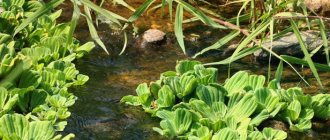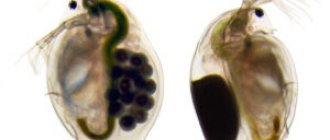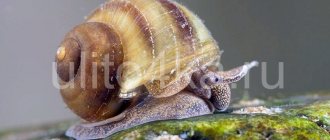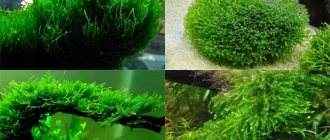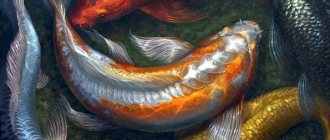10/04/2019Aquarium0
Daphnia is a crustacean organism. It is widely used as phytoplankton and food for aquarium inhabitants. It is quite difficult to create conditions for its breeding. Therefore, many aquarists use the services of pet stores, purchasing live, frozen or dried crustaceans in the required quantity.
- 1 Description, structure, lifestyle and natural habitat
- 2 Mr. Tail recommends: Daphnia as fish food
- 3 Value and benefits
- 4 Species of Daphnia
- 5 Daphnia in the aquarium
- 6 Nutrition of Daphnia
- 7 Catching Daphnia
- 8 Natural reproduction and breeding of Daphnia
- 9 Danger to humans
Description, structure, lifestyle and natural habitat
Daphnia belongs to the genus of planktonic crustaceans and is a cladoceran organism. The second name, Water Flea, was given due to its structure reminiscent of these insects and the ability to make sharp leaps in the water column. If you look under a microscope, you can make the following description of the appearance:
- a rounded body 2-6 mm long is enclosed in a bivalve shell made of transparent chitin;
- there are branched antennae on the head that help jumps in the water;
- There is only one compound eye in mature individuals, but there is an additional ocellus near it;
- in the front of the head there is a beak-shaped growth called a rostum, and under it there are antennae with olfactory bristles;
- 4-6 pairs of thoracic legs are covered with many setae and contain gill sacs intended for breathing and absorption of food;
- in the posterior part of the body there is a tail equipped with paired claws and an anus to cleanse the body of large foreign particles;
- Eggs form in a sac-like outgrowth on the back.
Photo gallery of Daphnia:
The size and color of Daphnia depend on its subtype and habitat. Thus, in spacious, clean reservoirs with a sufficient amount of oxygen and nutrients, light gray or greenish individuals live, and in small and polluted ponds they acquire a red-brown pigment.
The internal structure has the following characteristics:
- the brain and the nerve chain in the peritoneum are responsible for the nervous system;
- striated muscles help move the antennae, tail and thoracic legs;
- the digestive system consists of the mouth, small and middle intestines, 2 hepatic outgrowths and the hindgut with the anus;
- closer to the back is the heart, from which 2 ostia filled with blood arise;
- the respiratory organ is not expressed, oxygen enters the body through the membrane and from the growths of the legs;
- on both sides of the intestine there is a pair of ovaries in females or testes in males.
Daphnia live in freshwater bodies of standing water. They are distributed everywhere, including the lakes of Antarctica. For successful reproduction, they only need a clean environment with a minimum amount of silt and dirt at the bottom. Otherwise, there is a risk of accumulation of clogging substances in the intestines of crayfish, which leads to their death.
In the water column they exist as plankton, freely drifting with the current. They hide at the bottom when the sun shines too brightly, and the rest of the time they swim at the top. Life expectancy in a favorable environment is 22 days, and in a large individual it reaches 110-150 days.
Habitat
The ideal place for daphnia to settle are village ponds, which contain a lot of manure and oxygen-depleted water. Water fleas are resistant to changes in the amount of oxygen in water. This is explained by the fact that they are able to independently synthesize hemoglobin.
When oxygen decreases, hemoglobin in daphnia increases. They turn bright red and their numbers increase. With normal oxygen levels, crustaceans have a yellow-pink color.
Small crustaceans are permanent inhabitants of fresh water bodies, deep lakes, and small puddles. Many of them move along the bottom of a reservoir or the leaves of aquatic plants, and some scurry along the surface, periodically flapping their antennae.
Small puddles and roadside ditches are good habitats for the water flea. In them, the water temperature is close to atmospheric and enriched with oxygen. The drying up of small reservoirs threatens the death of all its inhabitants.
Mr. Tail recommends: Daphnia as fish food
Many aquarists and entrepreneurs prefer to grow Water Fleas as food crops for feeding small and young fish. You can also buy crustaceans in any form from them:
- live for home breeding;
- ice cream packaged in blisters;
- dry as ready-to-eat food.
This food has a number of positive aspects and has a positive effect on aquarium flora and fauna.
Springtails, Collembola
Springtails are six-legged animals. Their sizes are small, measured in millimeters. These are not aquatic inhabitants. You can find them in potted house plants and in the garden under leaves. They are often used as live food for surfeater fish. In an aquarium, they can take root on floating plants; they can often be found on islands of floating riccia. When disturbed, they jump short distances. They are harmless and useful in an aquarium only as live food for fish.
See also:
- Keeping fish and shrimp together in an aquarium
- Green pharmacy for aquarium
- How to prepare driftwood for an aquarium
For advertising purposes: | |
Value and Benefits
Daphnia is grown along with Bloodworm, Gammarus, Caddisfly, Amphipod, Cyclops, Prudovik and other food organisms. In terms of calorie content, they are all approximately equal, but the first has a higher protein content. Amino acids absorbed by young fish have a beneficial effect on their growth and development. Because of this, Daphnia is used commercially and added to many dry foods. In this form, 50% of their mass consists of proteins.
Live food is of particular importance in the diet of fish. It minimizes their incidence, is easier to digest during illness and facilitates adaptation to new conditions.
Crustaceans usually have a stomach filled with plant particles, so they are preferred as food by Guppies, Danios, Fire Barbs, Crucians, Carps and other aquatic inhabitants. In an aquarium, such nutrition is especially useful for fish deprived of a natural diet. The chitin shell, which is not digested, activates the intestines and starts its cleansing.
Moreover, they are unpretentious in care and multiply quite quickly. They benefit the entire aquarium by filtering the water in it. One individual eats 6 times more food per day than it weighs. This helps get rid of foreign microorganisms in a pond or tank.
What to feed:
There is no specialized food for daphnia as such. Various sources mention a wide variety of products from manure, yeast to finely chopped trout and bacon. However, most of them are not direct food for crustaceans, but serve as the basis for the development of bacteria and fungi, which daphnia already feed on. In the author’s subjective opinion, the optimal food is:
Specialized microfeeds for freshwater shrimp larvae are available in pet stores or upon order from fish suppliers.
Dry baker's yeast and regular wheat flour are sold in any grocery store.
Doug's mixture is the crowning achievement of culinary creation for daphnia. Consists of 1 part soy flour, 3 parts wheat flour, 1 part ground peas, 3 parts baker's yeast, 1 part paprika, 2 parts spirulina and/or chlorella algae.
Home experiments have shown that Doug's mixture is most effective, but requires a lot of time and ingredients to prepare. Similar results are obtained by combining baker's yeast and chlorella powder in a 50/50 ratio - this mixture is prepared much faster and easier. If desired, you can add a little paprika (1/10 part), which colors the daphnia, and is subsequently absorbed by the fish’s body and enhances their color.
Species of Daphnia
Their genus includes more than one hundred species of cladocerans, which belong to approximately 10 families. In Russia you can find three varieties:
- Magna is considered the largest, reaching a length of 6 mm in the female, 2 mm in the male and 0.7 in the larva. It matures in 12-14 days and gives birth in 2 weeks, laying an average of 20-30 and up to 80 eggs (ephippia) at a time. Lives approximately 110-150 days.
- Pulex is medium in size, the female grows up to 3-4 mm, and the male no more than 1-2 mm. It reproduces every 3-5 days, producing 10-25 eggs. The life cycle is 26-47 days.
- Moina is the smallest, has a soft shell and is suitable for feeding fry. It grows no more than 1.5 mm, and newborns are 0.5 mm. Maturation occurs within a day, and litters appear every 1-2 days, up to 53 ephippia each. Lives for approximately 22 days.
These three types can be bred even by amateurs, without requiring special maintenance. But the specifics of caring for them and interacting with other inhabitants are still worth knowing.
How to catch it from reservoirs yourself
Daphnia is caught from the end of spring until the end of autumn, until the reservoirs are covered with ice. It is recommended to catch in the morning or evening in cloudy, windless weather. In such conditions they rise closer to the surface of the water. For fishing, you can use a regular fabric net.
Caught specimens should be placed in a tin container and shaken periodically. It should be remembered that at high densities they may die during transportation. At home, the crustaceans are washed and passed through a sieve to sort by size.
Daphnia in the aquarium
To breed crustaceans in closed tanks, you must provide certain conditions for their existence:
- choose a clean container made of glass or plexiglass, initially with a capacity of 1-3 liters, replacing it as the number of inhabitants increases, taking into account a density of 0.3-1 kg/m³;
- use purified water or from the tap, with a hardness of 6-18° and a neutral pH of 7.2-8, without chlorine and chemical impurities, for which it can be filtered;
- place it away from direct sunlight, as crustaceans do not like excessive light;
- install a 20 W fluorescent lamp, providing light lighting for 14-16 hours every day;
- provide temperatures within +20…+24 °C for Daphnia vulgaris and +26…+28 °C for Moin; in a cool habitat the reproduction rate will decrease;
- provide complete nutrition by dissolving the fertilizer in the liquid until it becomes slightly cloudy, and adding a new portion after clearing;
- as necessary, clean and change the water so that debris and silt do not accumulate at the bottom, as well as plaque on the walls;
- use weak aeration to remove film on the surface, mix food, provide oxygen access of at least 3-8 mg/l and oxidation 14.8-26.2 mg O2/l.
First, you should purchase crustacean eggs and place them in a prepared container. Already matured individuals need to be caught with a net in order to immediately be fed, dried or frozen.
Raising water fleas
Growing Daphnia
To provide aquarium inhabitants with environmentally friendly food, Daphnia is grown at home:
- First of all, you need to prepare a tank in which crustaceans will breed. This can be any plastic container suitable for food; plastic drinking water bottles are often used.
- Crayfish are not particularly picky about the composition of water. The main thing is that there are no impurities of salts or metal compounds in it.
- Yeast and green algae are used as food. The latter actively develop in sunlight. It is enough to place a bottle filled with water with a microalgae culture in a warm place, and after 10-14 days you will be able to feed water fleas with “your own” grown food.
- In order for crustaceans to actively reproduce, it is necessary to create favorable conditions for them: a temperature of 23-25 ° C and 24 hours of daylight.
- Periodically, the daphnia culture and water are renewed.
Fresh water fleas have the highest nutritional value. When frozen, they lose some of their enzymes and amino acids.
Nutrition of Daphnia
In nature, Water Fleas feed on simple microorganisms:
- blue-green algae from unicellular organisms;
- ciliates;
- fungal spores;
- bacteria;
- detritus (remains of invertebrate animals).
A suitable environment is created in ponds with a small number of fish and a large number of phytoplankton, which creates the effect of a bloom in the water column. In artificial tanks, crustaceans should be fed with the following products:
- The bacteria are obtained from banana peels, food waste or excrement. To do this, they should be soaked in water for up to a week until it begins to become cloudy. Add the resulting liquid to the tank, 450 ml per 20 liters, every 5-6 days.
- Microscopic algae and other plankton will remove excess contaminants and serve as food for Water Fleas. To obtain them, you should scoop up the liquid from the stocked aquarium and place it in a sunny, warm place at +18...+25 °C.
- Yeast can be dried or raw, frozen to a rich color. Dilute in water at +35 °C at the rate of 1-3 g per 1 liter. They should be used 2-3 times a week, in combination, as they have less nutritional value.
- Beetroot, cabbage or carrot juice will serve as a vitamin supplement. You need to add 1 tsp to the container. for 5 liters of volume.
- Dry the elodea, nettle or lettuce, chop it, grind it in gauze, and add it to a container of water. When it turns green, introduce crustaceans there. Repeat every 10-15 days.
- A couple of times a week you can add ammonium nitrate at 1 g/100 l, phosphorus salts up to 5 mg/l, or other mineral fertilizers.
- Stale blood or water remaining from washing fresh meat (1.5-2 cm3/l), blood or meat and bone meal (0.5-2.5 cm3 per 10 l), manure (1.5 kg/m3).
During the feeding process, crustaceans create a current by raking with their chest paws. It is on them that the organs that send microelements to the esophagus are located. Inside there are organs that produce a sticky substance that collects individual food particles into clumps. Inside the esophagus, they go through all stages of digestion and only large excesses come out.
Feeding unsuitable food
Daphnia are filter feeders that feed on bacteria, yeast, and microalgae. Each species has its own habitats and tasks that they perform in nature. This is where my dietary preferences were formed. For example, Moina mostly lives in ditches, puddles, and water with a high concentration of organic matter; accordingly, a bacterial type of nutrition is more suitable for it. It grows well with yeast and milk, and is not afraid of a little overfeeding.
Daphnia pulex lives in cleaner waters, the bacterial type of nutrition suits it, but it does not tolerate overfeeding, just like Daphnia Magna, so uncontrolled introduction of a yeast suspension into a weak culture can lead to the death of the crustacean. It is better to feed these species with unicellular algae, which remain suspended in the water column for a long time and do not spoil it.
The food is chosen by the aquarist, which is more convenient, experimentally. The most common are dry baker's yeast, milk, dry infant formula, spirulina powders, chlorella, live single-celled algae, powders from dried nettle leaves, lettuce, and so on. I would like to add that the nutritional value of daphnia also depends on what it eats.
Catching Daphnia
Water fleas can be collected independently from small lakes, ponds with waterfowl, pits, ditches and other bodies of water with minimal aquatic life. They do not breed in river conditions, but only in standing water. They are quite easy to detect by coloring the thickness in a gray-green or brownish tint.
You should not look for them in heavily dammed reservoirs or lakes with many fish and predators. The presence of the latter will affect not only the quantity of plankton, but also its quality, and will also increase the risk of the spread of diseases to aquarium fish.
To catch bioplankton, you need to take a fine-mesh net or muslin sieve. The scooping motion should follow a figure eight shape and be slow. Rapid scooping leads to increased pressure on the crustaceans and to their death.
The best time for this is during the period of water bloom, when the concentration of algae in it increases. Moreover, it is easier to do this in a shaded area of shallow water, in the evening or on a cloudy day. After all, the attitude of crustaceans to bright sunlight is negative; under them, plankton-like creatures tend to go deeper closer to the bottom.
Where does it live?
Found throughout the globe. Scientists have discovered some representatives even in Antarctica. This fact indicates how well they adapt to various living conditions and the possibility of transformation into other species.
Daphnia adapts to a new environment, with each species living in its own habitat.
Some species prefer subtropics and temperate zones to live. The smallest number inhabit the equator and tropical climates. A number of species inhabit America and Great Britain, Europe and Asia. Crustaceans prefer standing water and do not like currents. Therefore, a pond or lake, as well as small puddles, are considered a favorite habitat. Mostly the number inhabits fresh water.
Arthropods that find themselves in drought conditions can move to a salty body of water. The ability to adapt keeps them alive.
Clean water with minimal soil content is considered the best habitat.
The crustacean feeds by filtering, so the cleanliness of the reservoir comes to the fore.
Natural reproduction and breeding of Daphnia
Water fleas are not asexual creatures, as evidenced by the presence of ovaries in females and testes in males. They also differ in the size and structure of the antennae. But in them, like all cladocerans, reproduction occurs through cyclic parthenogenesis. Same-sex reproduction is especially important when only female individuals remain in the population. Moreover, in warm summer weather, young females develop from their unfertilized eggs. In autumn and when water bodies dry up, males emerge from such ephippia. Their embryos are born under the shell and wait several molts before emerging.
When fertilization is complete, smaller and faster males mate with females, attaching themselves to the rear edge of the shell. During parthenogenesis, all litters are the same sex. After colder weather and decreased daylight hours, bisexual reproduction occurs. In this case, some individuals give birth to males, while others lay ephippia, which are dormant until fertilization. They spread with the wind, on the legs or feathers of birds, the fur of mammals, and in the intestines of fish. In winter, they are found on the water surface or in the upper layers of silt. They are resistant to frost or drying out, and when placed in a favorable environment, embryo development begins.
For cultivation, dry eggs are taken and placed in a suitable environment. They grow and multiply quickly, which makes it possible to obtain 30-50 g of crustaceans from 1 m3 of ephippia. Feeding has two directions:
- Joint, in which food is brought into the tank with Daphnia. The negative is rapid contamination and the need for frequent fluid replacement.
- Separate is convenient for mass breeding. At the same time, algae is grown in a separate container, which is introduced into the tank 1-2 times a day during feeding.
Industrial cultivation of forage crustaceans in large pools and dams is now popular. In this case, the producer changes the water and replants the crop every few weeks or months to prevent it from aging.
General information:
Daphne is a deciduous, semi-deciduous and evergreen shrub belonging to the Timeleaceae family. Wolfberry or wolfberry, as it is also popularly called, is a very poisonous plant.
Previously, ropes and ropes were made from Daphne bark because its bark is very strong and tough. There are about fifty species of these shrubs. All its types are considered decorative.
Daphne is an early flowering shrub. Daphne begins to bloom even before the leaves appear, around the beginning of April. The flowers of this plant are very fragrant, white, purple, pink, cream and even crimson. Double-leafed flowers have up to four petals and are star-shaped. The berries are very brightly colored and very poisonous, ripening in the fall. Daphne's homeland is considered to be Europe, North America and Asia.
Danger to humans
Because of their association with insects, many people believe that Water Fleas bite. But they do not have the corresponding organs, which means that such bites are excluded. Daphnia can cause harm only by causing an allergic reaction in people predisposed to it. As they absorb food, they also accumulate dangerous pollen, the concentration of which increases in dried organisms.
According to statistics, crustaceans cause allergies in almost every fourth person. It manifests itself in the following symptoms:
- itchy skin rashes, like hives;
- dryness and congestion of the nasal sinuses, runny nose;
- frequent involuntary sneezing;
- allergic conjunctivitis with tearing;
- difficulty breathing due to bronchospasm;
- bronchial asthma.
To diagnose the condition, doctors analyze a skin test. In case of positive results, antihistamines are prescribed and contact with Daphnia is avoided.
ECOLOGICAL STOICHIOMETRY
The ecology of Daphnia pulex is determined by the availability and balance of nutrients, which influence traits that mediate intra- and interspecific interactions. Because nutrients are required for a variety of biological processes—for example, amino acid synthesis—the availability of these nutrients in the environment regulates subsequent characteristics of the organism. Low nutrient availability reduces both body size and growth rate, which, as noted above, regulates Daphnia's relationship with predators. In particular, Daphnia pulex is an important model species for environmental stoichiometry research, demonstrating that pond shading by trees increases nutrient concentrations relative to carbon in algae, which increase D. pulex body size and hence competitiveness and susceptibility to vertebrate predation .
